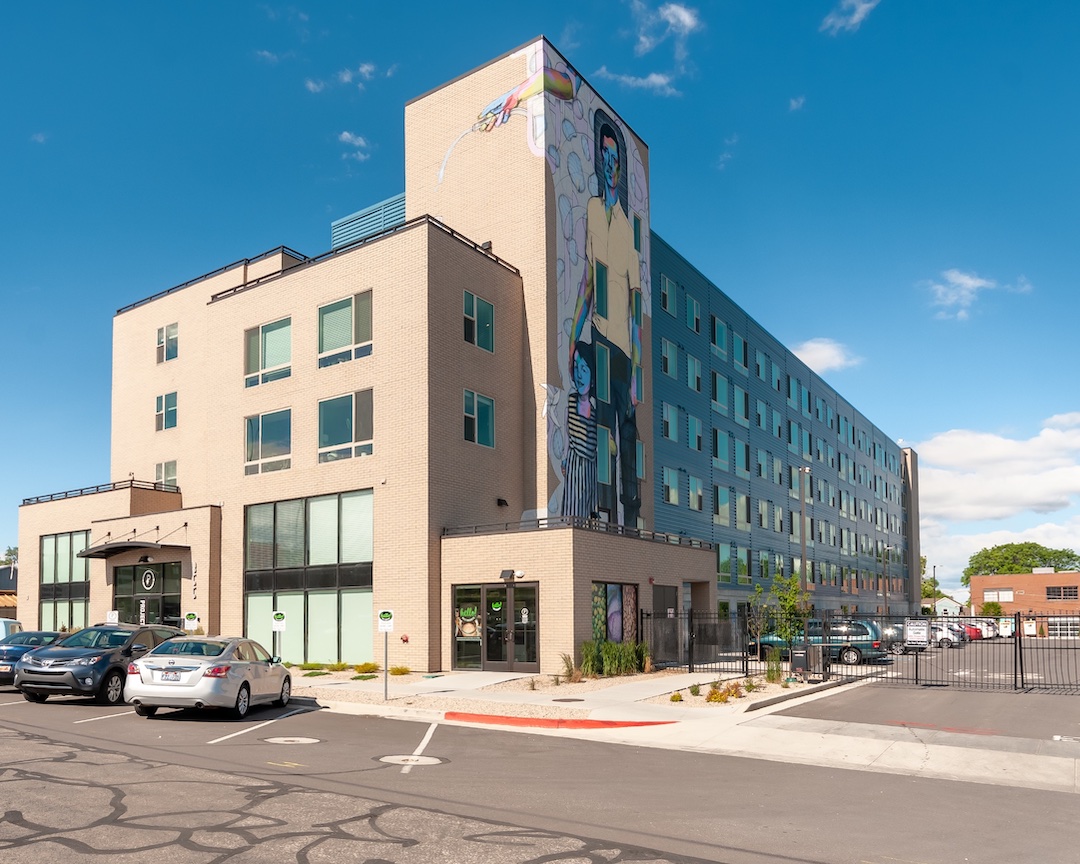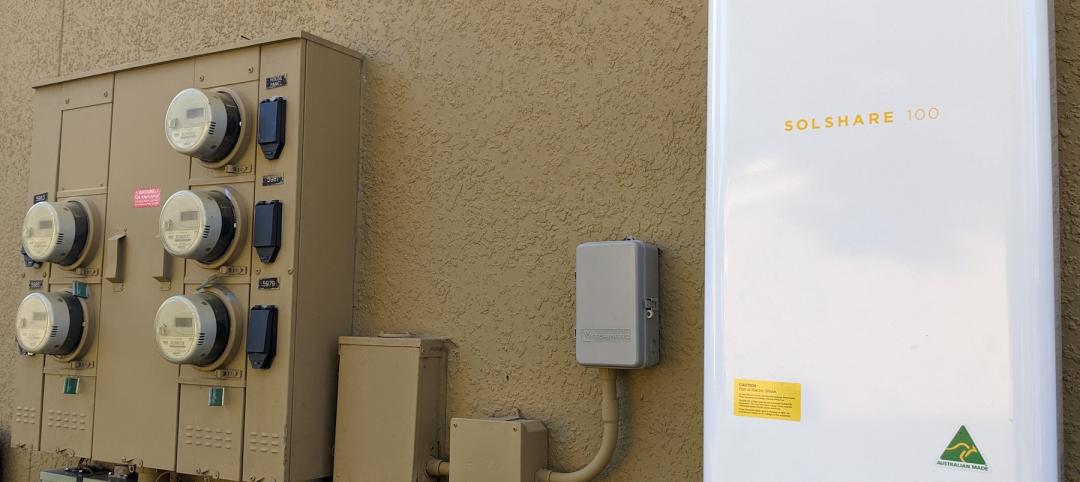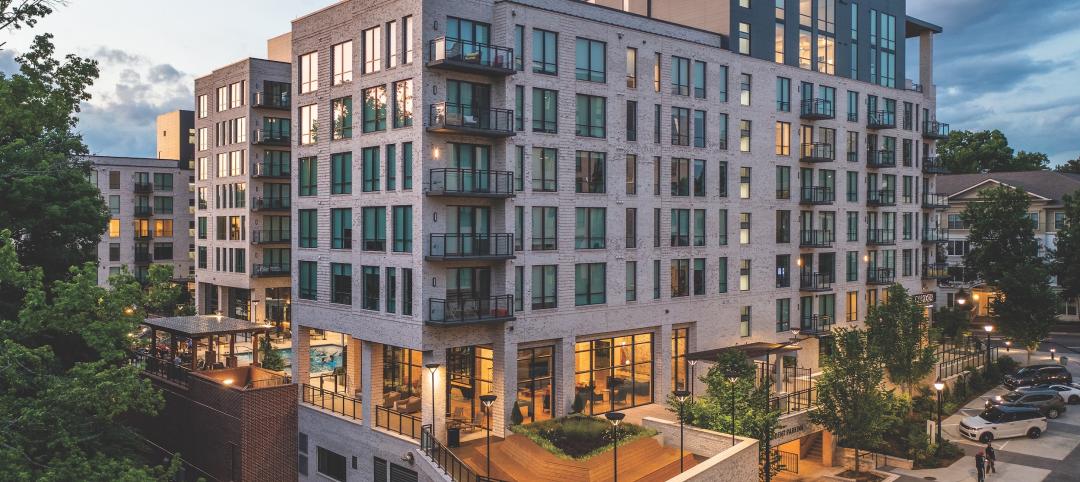The $16 million Project Open rental community of 112 one-bedroom units is the product of Giv Development, a Salt Lake City developer that specializes in mixed-income housing communities. Its not-for-profit arm explores new concepts for affordable, sustainable housing.
“We’re interested in developing a scalable net-zero model that will start to shift market dynamics and encourage developers to recognize that building this way is the economically intelligent thing to do,” said Giv Group Executive Director Chris Parker.
The all-electric building is located in the city’s Guadalupe neighborhood, an urban district on the front lines of gentrification. “We want the building to serve as a bulwark against the population being pushed out as property values continue to rise,” said Parker.
About 70% of Project Open’s units are set aside as affordable, some with rents as low as $375 a month. A historic furniture warehouse behind the building was converted into amenity spaces and 14 studio workspaces for rent by resident artists and entrepreneurs.
“I love what Giv is doing to make sure the neighborhood will remain affordable for people who have lived here for generations,” said tenant Valarie Williams. She moved into the building when it opened in January 2017 and also rents studio space for her part-time hand-lettering business. “The fact that it’s sustainable and also gives me a space in which to create was icing on a really great cake,” she said.
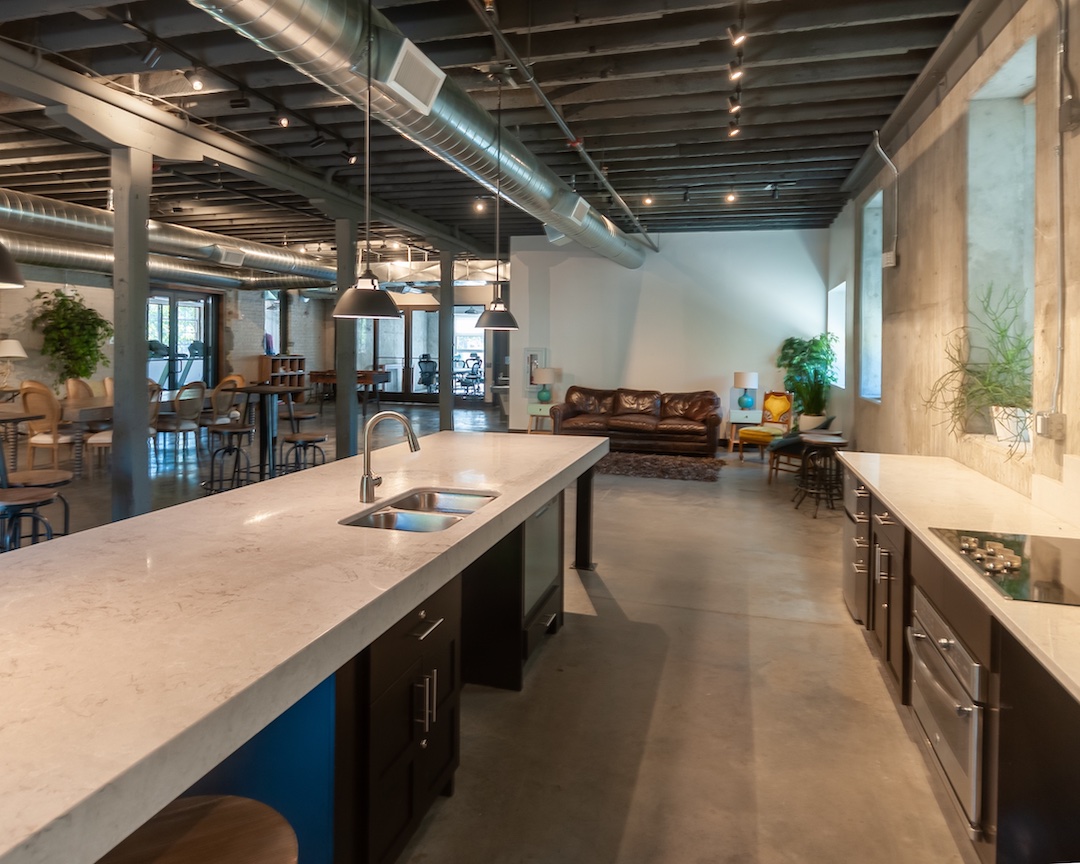 The clubhouse of Project Open resides in a historic furniture warehouse that Giv Development renovated into 14 affordable creative studios, a gym, and a conference room, in addition to the clubhouse. The reconstructed building is now another emission-free component of Giv’s Project Open complex. Photo: Brandon Hyatt Photography
The clubhouse of Project Open resides in a historic furniture warehouse that Giv Development renovated into 14 affordable creative studios, a gym, and a conference room, in addition to the clubhouse. The reconstructed building is now another emission-free component of Giv’s Project Open complex. Photo: Brandon Hyatt Photography
Goldman Sachs, Olene Walker Housing Loan Fund, and Utah Housing Corporation provided funding. Although no solar tax credits were issued, Rocky Mountain Power set up the solar program and provided transportation and energy-efficiency rebates.
Lowering carbon emissions is a high priority in Salt Lake City. Air quality is particularly poor during winter months, when prolonged inversions cause cold, stagnant air to settle in mountain basins and trap pollutants. The metro area ranked eighth nationally in so-called PM2.5 spikes, which measure small particulate matter pollutants, according to the American Lung Association’s 2019 “State of the Air” report.
Addressing the region’s air quality problems is “an issue that has to be taken up collectively or no one gets much benefit,” said Parker. “Utah’s population is expected to double in the next 30 years, so there’s a bit of urgency here.”
FINE-TUNING THE carbon neutral apartment APPROACH
Space limitations on the roof made it impossible to power the entire six-story building with rooftop PVs. Instead, residents purchase their electricity from Rocky Mountain Power’s Subscriber Solar program, via solar panels housed at a power facility in central Utah. “The program offers reliable solar production without any upfront capital costs, which provides a real market incentive to move to electrification,” said Parker.
Each residence is heated and cooled by an individual heat pump, but Giv also opted to install a supplemental resistance heating system to make sure residents can stay warm in Utah’s brutal winters. Tankless electric water heaters added to total energy demand, necessitating an upgrade to a 150-amp circuit breaker in each unit.
“It really caught us off guard how difficult and time-consuming it was going to be to route power to the units,” said Tyler Hollon, Business Development Specialist at general contractor Wadman Corporation. “We had to run six-gauge wires to each unit and didn’t really plan for enough room in the walls to make everything fit.”
Hollon anticipates all-electric buildings will become the local standard as technology advancements and construction ingenuity continue to make the project economics more appealing. “I wouldn’t be surprised if half the units will be built this way in two years,” said Hollon, whose firm is currently building about 1,200 carbon-neutral residential units throughout the Salt Lake City area.
Related content: Deluxe parking: A condo building in Philadelphia offers its owners a completely automated parking service
Project Open phase two, currently under construction and scheduled to open later this year, will offer a wider range of living options, from live/work studio apartments to four-bedroom units. The two-building complex will integrate high-efficiency mini-split heat pumps, hybrid heat pump water heaters, and no-backup resistance heating units to save energy. It will also incorporate more amenities that support a low-carbon lifestyle, such as an electric vehicle ride-share program, e-bikes, and a fresh food space to lessen the need for frequent trips to the grocery store.
A planned third phase, expected to break ground in 2020, will incorporate some condominium units.
Ultimately, Giv wants to provide local developers, contractors, and architects with real-world residential models that outperform conventional properties from an economic, environmental, and social equity standpoint. Project Open is creating a public website where it will share real-time data on each building’s energy use, construction costs, and the specific building systems and products that were used.
“We envision Project Open as an open source research tool for anyone—including us—to keep thinking about solving the challenges we currently have with the way we build,” said Parker.
PROJECT TEAM | PROJECT OPEN, PHASE ONE
DEVELOPER Giv Development
ARCHITECT Architecture Belgique
STRUCTURAL ENGINEER Canyons Structural
CIVIL ENGINEER Focus Engineering
MEP ENGINEER PVE
ENERGY CONSULTANT Provident Energy
GENERAL CONTRACTOR Wadman Corporation
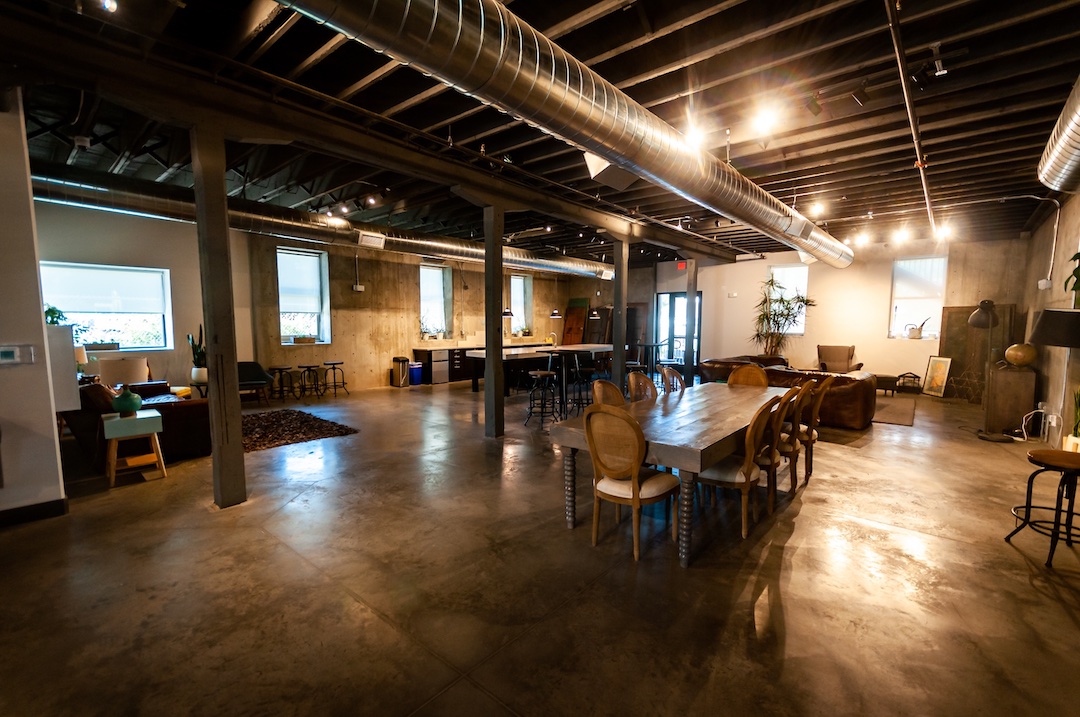 Photo: Brandon Hyatt Photography
Photo: Brandon Hyatt Photography
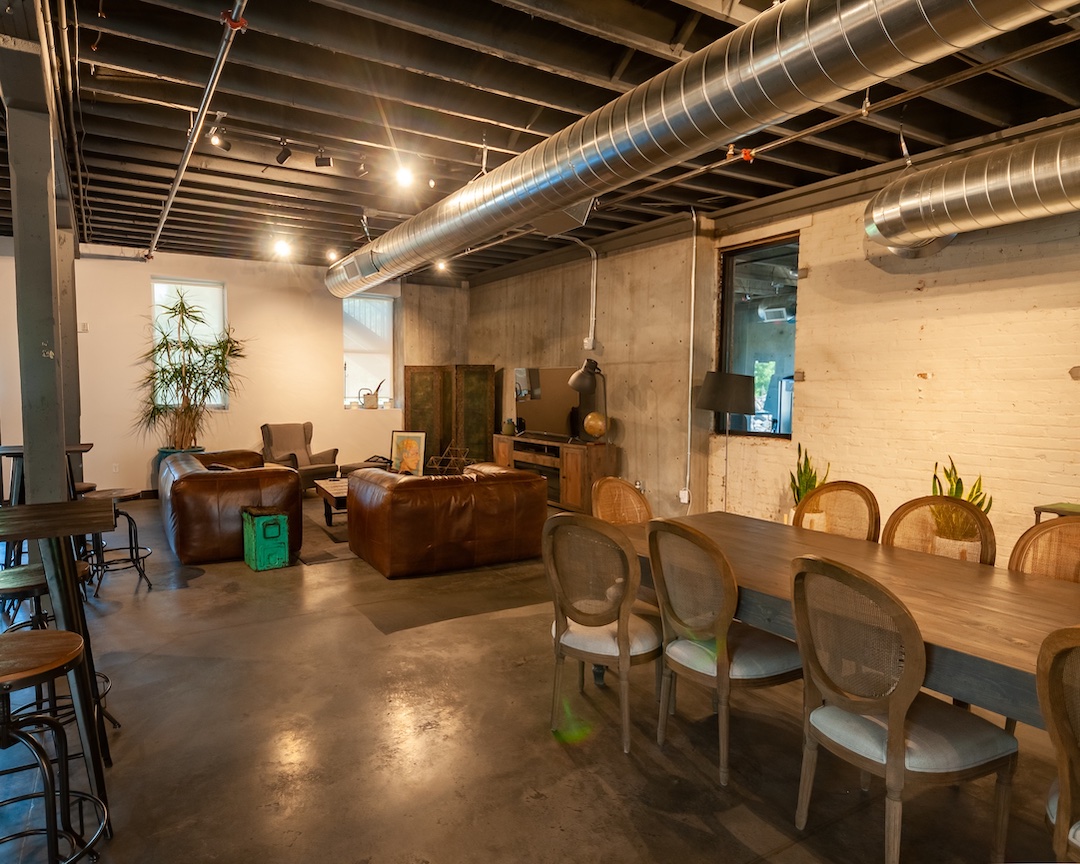 Photo: Brandon Hyatt Photography
Photo: Brandon Hyatt Photography
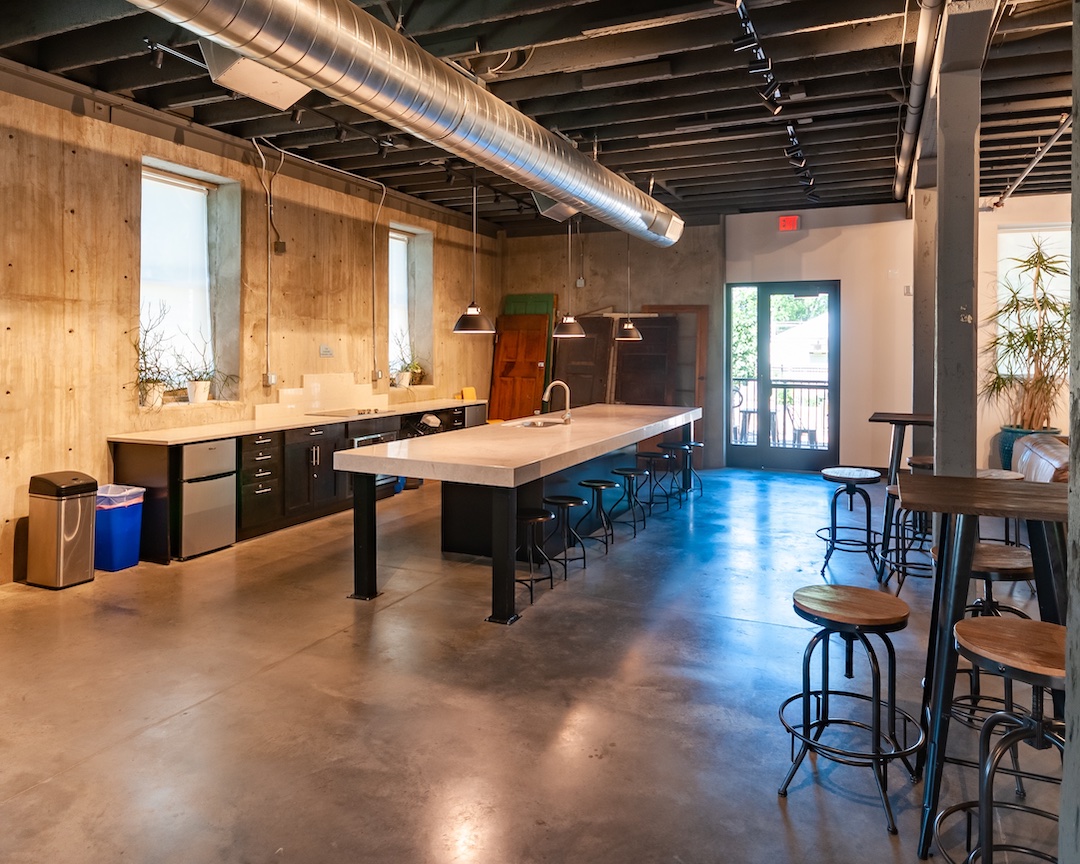 Photo: Brandon Hyatt Photography
Photo: Brandon Hyatt Photography
Related Stories
Multifamily Housing | Apr 21, 2023
Arlington County, Va., eliminates single-family-only zoning
Arlington County, a Washington, D.C., community that took shape in the 1950s, when single-family homes were the rule in suburbia, recently became one of the first locations on the East Coast to eliminate single-family-only zoning.
Green | Apr 21, 2023
Top 10 green building projects for 2023
The Harvard University Science and Engineering Complex in Boston and the Westwood Hills Nature Center in St. Louis are among the AIA COTE Top Ten Awards honorees for 2023.
Multifamily Housing | Apr 20, 2023
A solution for sharing solar energy with multifamily tenants
Allume Energy’s SolShare sees lower-income renters as its primary beneficiaries.
Multifamily Housing | Apr 19, 2023
Austin’s historic Rainey Street welcomes a new neighbor: a 48-story mixed-used residential tower
Austin’s historic Rainey Street is welcoming a new neighbor. The Paseo, a 48-story mixed-used residential tower, will bring 557 apartments and two levels of retail to the popular Austin entertainment district, known for houses that have been converted into bungalow bars and restaurants.
Multifamily Housing | Apr 17, 2023
World's largest multifamily building pursuing ILFI Zero Carbon certification under construction in Washington, D.C.
The Douglass, in Washington, D.C.’s Ward 8, is currently the largest multifamily housing project to pursue Zero Carbon Certification from the International Living Future Institute (ILFI).
Sponsored | Multifamily Housing | Apr 12, 2023
With affordability and innovation for all: Multifamily housing ideas break barriers
With a growing need for multifamily housing solutions at all income levels, the U.S. market is seeing a proliferation of inventive projects. Alongside the creativity is a nascent move toward higher quality, if not always larger unit sizes, with offerings of better amenities both inside and outside today’s latest residential solutions.
Urban Planning | Apr 12, 2023
Watch: Trends in urban design for 2023, with James Corner Field Operations
Isabel Castilla, a Principal Designer with the landscape architecture firm James Corner Field Operations, discusses recent changes in clients' priorities about urban design, with a focus on her firm's recent projects.
Market Data | Apr 11, 2023
Construction crane count reaches all-time high in Q1 2023
Toronto, Seattle, Los Angeles, and Denver top the list of U.S/Canadian cities with the greatest number of fixed cranes on construction sites, according to Rider Levett Bucknall's RLB Crane Index for North America for Q1 2023.
Contractors | Apr 10, 2023
What makes prefabrication work? Factors every construction project should consider
There are many factors requiring careful consideration when determining whether a project is a good fit for prefabrication. JE Dunn’s Brian Burkett breaks down the most important considerations.
Affordable Housing | Apr 7, 2023
Florida’s affordable housing law expected to fuel multifamily residential projects
Florida Gov. Ron DeSantis recently signed into law affordable housing legislation that includes $711 million for housing programs and tax breaks for developers. The new law will supersede local governments’ zoning, density, and height requirements.


